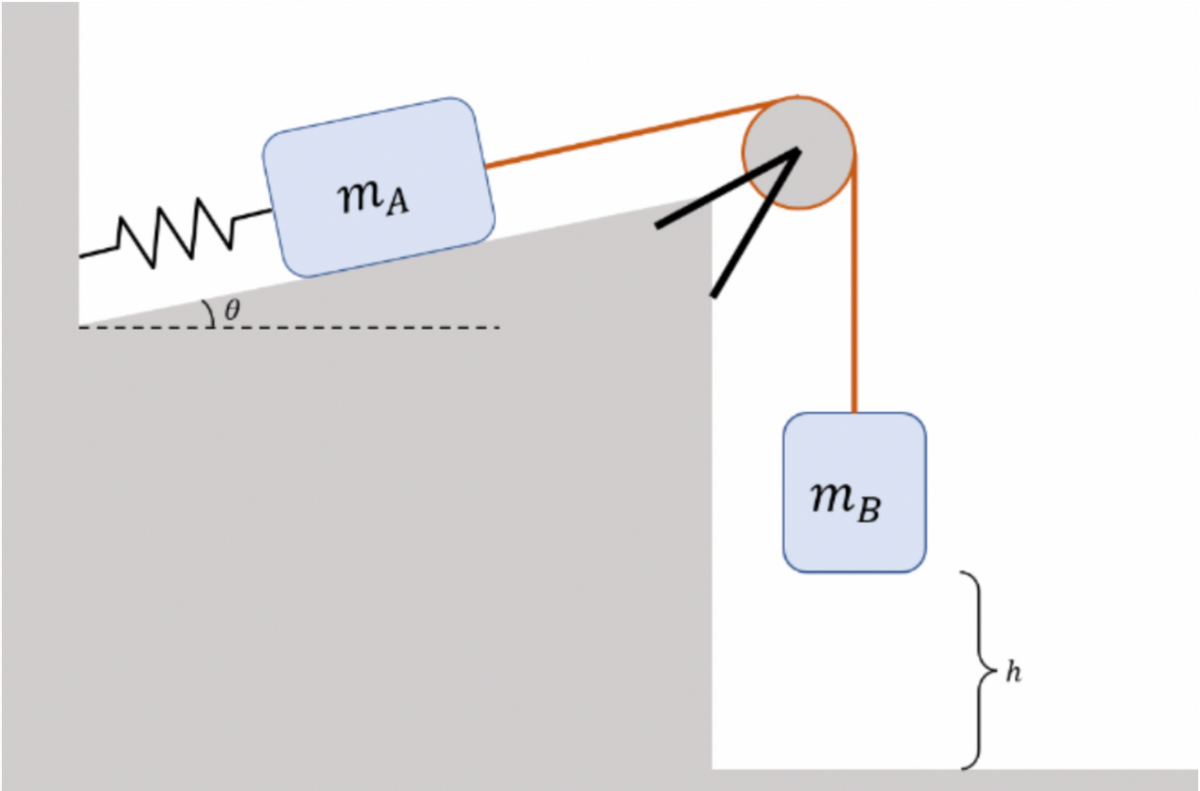LOAD This exercise is part of a series of problems aimed at modeling a situation by progressively refining our model to take into account more and more parameters. This progressive approach is very close to what professional scientists do! context We want to lower a suspended load in a controlled way so that it hits the ground with a speed whose modulus is not too great. To slow down the descent, a spring has been added behind the mass (A), The suspended load (B) is connected by a rope passing through a pulley to this mass (A), which slides on a horizontal surface with friction. Information The masses of the charges A and B are known. The mass of the rope itself is negligible (very small compared to the loads). The pulley has negligible mass and can rotate without friction. The charge B is initially stationary and is at a known height h. The surface on which mass A sits is tilted upwards at a known angle theta from the horizontal. There is friction under mass A: the kinetic friction coefficient uc is known. The string attached to mass A is perfectly parallel to the surface on which the mass is resting, as is the spring. The spring is initially at its natural length and has a known spring constant k. Schematization Represent the initial and final states of the system, identifying an upward y-axis for each object. This is especially important here. Modelization Create a model for the modulus of the velocity with which load B will hit the ground given the known parameters only. Then test your model with the following values: Mass of the load A: 85kg Mass of suspended load (B): 97kg The initial height of suspended mass (h): 1.2m Coefficient of friction under mass A: 0.15 Spring constant: 118.1 N/m The angle of inclination of the surface on which the mass A is placed is 8.8 degrees
LOAD
This exercise is part of a series of problems aimed at modeling a situation by progressively refining our model to take into account more and more parameters. This progressive approach is very close to what professional scientists do!
context
We want to lower a suspended load in a controlled way so that it hits the ground with a speed whose modulus is not too great. To slow down the descent, a spring has been added behind the mass (A), The suspended load (B) is connected by a rope passing through a pulley to this mass (A), which slides on a horizontal surface with friction.
Information
The masses of the charges A and B are known.
The mass of the rope itself is negligible (very small compared to the loads).
The pulley has negligible mass and can rotate without friction.
The charge B is initially stationary and is at a known height h.
The surface on which mass A sits is tilted upwards at a known angle theta from the horizontal.
There is friction under mass A: the kinetic friction coefficient uc is known.
The string attached to mass A is perfectly parallel to the surface on which the mass is resting, as is the spring.
The spring is initially at its natural length and has a known spring constant k.
Schematization
Represent the initial and final states of the system, identifying an upward y-axis for each object. This is especially important here.
Modelization
Create a model for the modulus of the velocity with which load B will hit the ground given the known parameters only.
Then test your model with the following values:
Mass of the load A: 85kg
Mass of suspended load (B): 97kg
The initial height of suspended mass (h): 1.2m
Coefficient of friction under mass A: 0.15
Spring constant: 118.1 N/m
The angle of inclination of the surface on which the mass A is placed is 8.8 degrees

Step by step
Solved in 2 steps with 1 images
